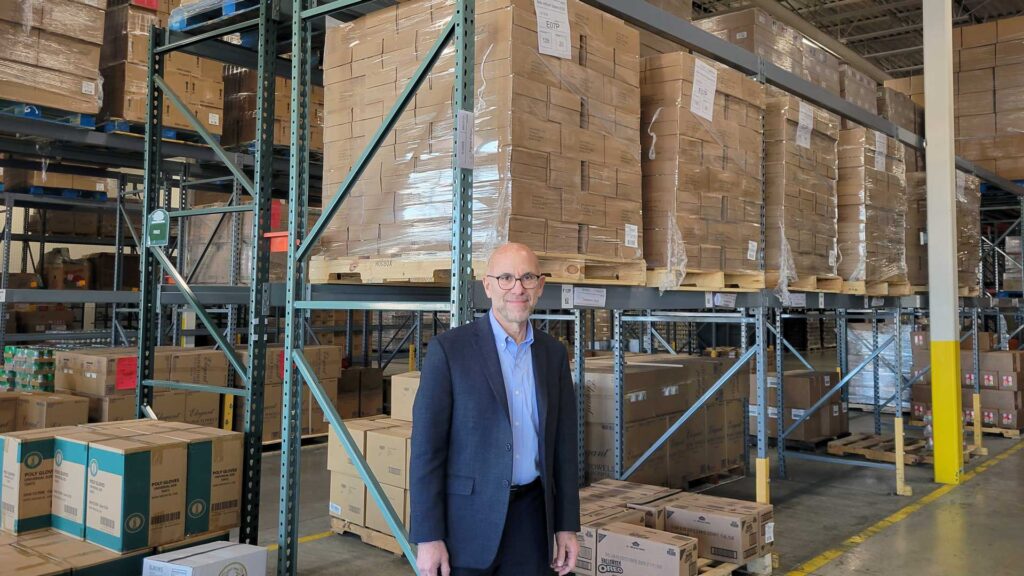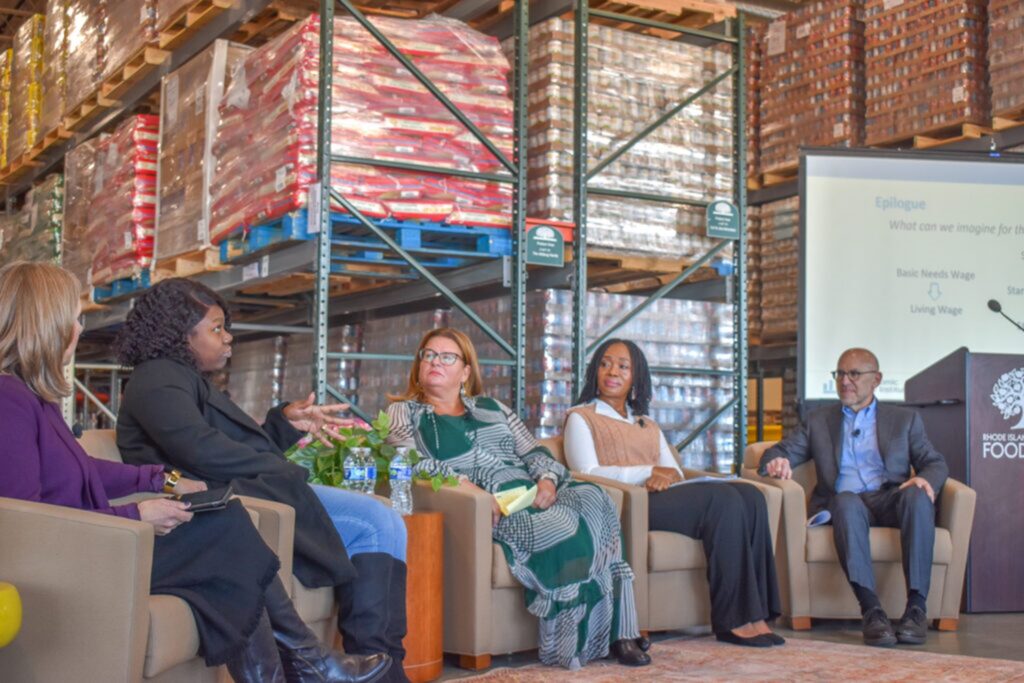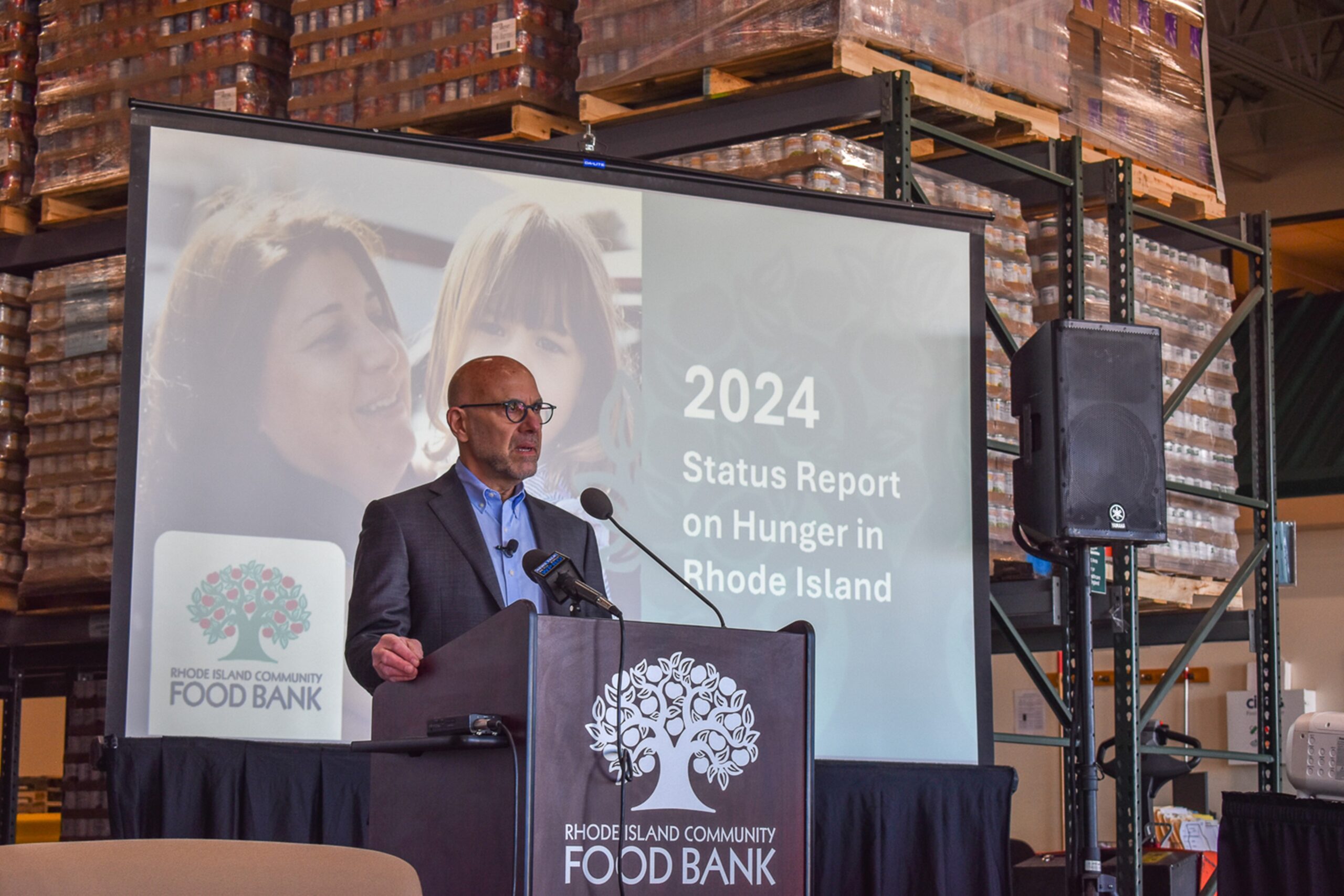“That’s just not sustainable. It’s scary.”
This story was originally published in Rhode Island Current, a publication partner of Ocean State Stories.
PROVIDENCE — Nearly two in every five households across the Ocean State struggle to afford adequate meals for their families, according to a new report from the Rhode Island Community Food Bank.
The six-page report released Monday found an average of 38% of Rhode Island households in the last year were considered food insecure. It also noted that food pantries in the state served an average of 84,400 individuals per month between January and September of this year — a 9% increase from the same period in 2023. That puts need at an all-time high, said Community Food Bank CEO Andrew Schiff.

Speaking at a town hall-style meeting inside the organization’s Providence distribution center Monday morning, Schiff attributed the spike to high living costs and a “meal gap” resulting from inadequate coverage by federal programs.
“This is the essence of food insecurity,” he said.
Schiff gave a brief overview of the report before taking part in a discussion with Economic Progress Institute Executive Director Weayonnoh Nelson-Davies and with the executive director of the Martin Luther King Jr. Community Center in Newport, Heather Hole Strout. A mother whose family relies on the MLK Center’s food pantry also spoke.
A single adult needs an estimated $39,741 a year to meet basic needs in the state, according to the Economic Progress Institute’s 2024 Rhode Island Standard of Need report — more than double the $14,580 suggested by the federal poverty level.
A single parent of two children would have to spend roughly $83,000 per year to afford rent, utilities, transportation, child care and health care. They would have to have an annual income of $99,000 to meet those basic needs, according to the Economic Progress Institute’s report.
“How many single-parents are making that $99,000 a year?” Nelson-Davies asked the crowd. “Not a lot.”
Around 78% of Rhode Island single-parent households with two children make less than that required income, according to the Economic Progress Institute.
Oftentimes, Schiff said, low-income families have to make the choice between paying for food or shelter — with housing always being the priority. That means meals are often skipped.
Low-income residents in Rhode Island missed more than 42.2 million meals in the last year, the food bank’s 2024 report states.
Even a family of five using federal meal benefits can struggle to keep up with Rhode Island’s high cost of living. Such is the case of Imani Hepburn-Vaughn, who moved to Newport in 2022 from Pensacola, Florida, when her husband was transferred by the U.S. Navy. She told the crowd that the move with their three children was a “culture shock,” especially when she saw the $8 price of a bag of sweet peppers at the grocery store — something that was only $3 back in Florida.
“What we were accustomed to eating back home, we couldn’t do that here” Hepburn-Vaughn said. “The money just wasn’t stretching.”
But she was able to get fresh produce after she was referred to the food pantry at the Martin Luther King Jr. Community Center in Newport. She admitted she was almost too proud to go to the center.
“It’s very empowering to be self-sufficient and then going to not being it, it can feel very painful,” said Hepburn-Vaughn, who gave birth to a fourth child after moving to Rhode Island. “Coming to MLK, I was very hesitant — I wasn’t sure how I would be received. But I’m two years in, so we can assume it went well.”
Hepburn-Vaughn said she stops by the MLK Center every weekend to get fresh produce. The center’s volunteers are able to fulfill the order, but Strout, its executive director, told the crowd that demand at the food pantry has doubled since 2023.
“We’ve never seen anything like that and honestly, that’s just not sustainable — it’s scary,” Strout said.

The increase in food demand also proved to be a problem for the Rhode Island Community Food Bank, which saw rows of empty shelves at its Providence distribution center during the summer.
Ahead of Thanksgiving, most shelves were stocked. Things stabilized after the United States Department of Agriculture revamped its meal delivery system, along with seasonal donations from farms and more funding to purchase food in bulk, Schiff told Rhode Island Current after the town hall.
But to ensure demand at food pantries goes down, Schiff said Congress must increase the federal government’s Supplemental Nutrition Assistance Program benefits through the Farm Bill currently under consideration.
“My worry is that Congress will actually cut SNAP benefits in the Farm Bill, which will only send more people to food pantries and only increase the meal gap,” Schiff said.
Initial projections in October show the state faces a $400 million shortfall for the fiscal year that starts July 1, 2025. Nelson-Davies expressed concerns over the potential for cuts to Medicaid into Rhode Island’s fiscal year 2026 budget.
“And that’s the opposite of what we need right now,” Nelson-Davies said.
However, Nelson-Davies said she is optimistic public pressure could make state leaders find new sources of revenue and at least maintain existing services as they look over the budget early next year.
“We’re a small state and I’m always thinking about how we can be a model for the nation — a lot of states are going to feel the impact,” she said. “These are real families, real people impacted.”
Read about statewide food insecurity last year: part one and part two, from Ocean State Stories.
Read an Ocean State Stories Q & A with Economic Progress Institute Executive Director Weayonnoh Nelson-Davies.
Read “Thanksgiving: A holiday with two decidedly different narratives,” this week from Ocean State Stories.






